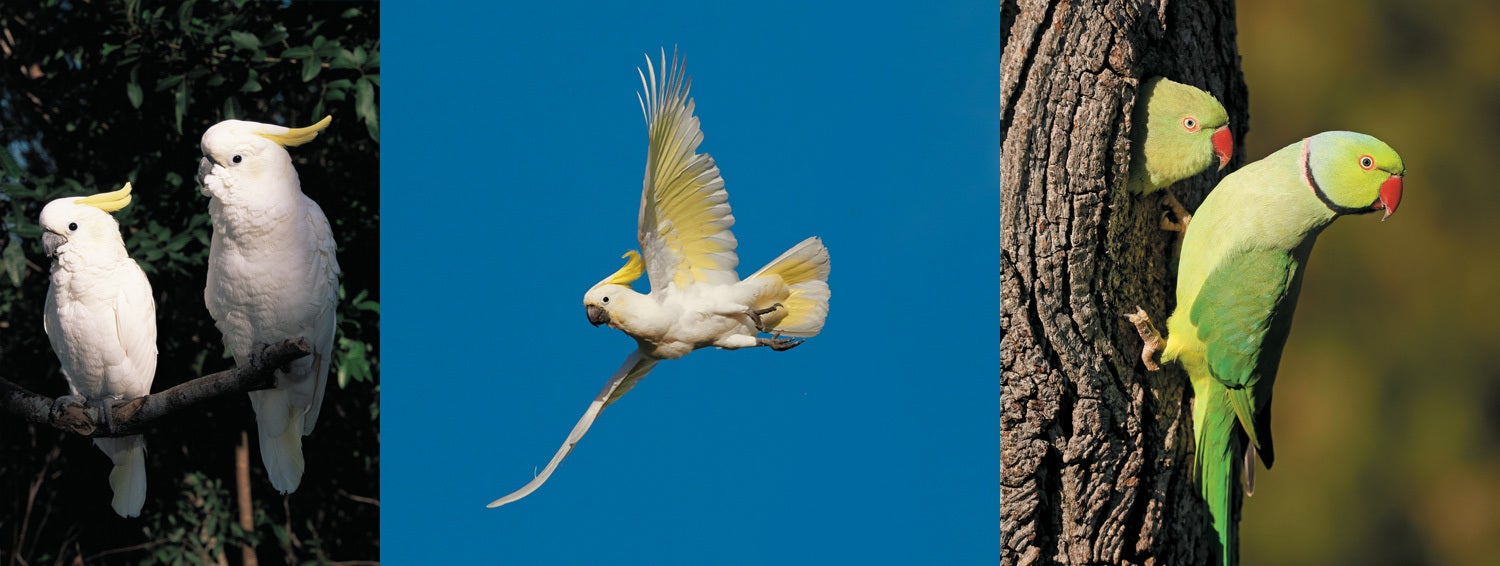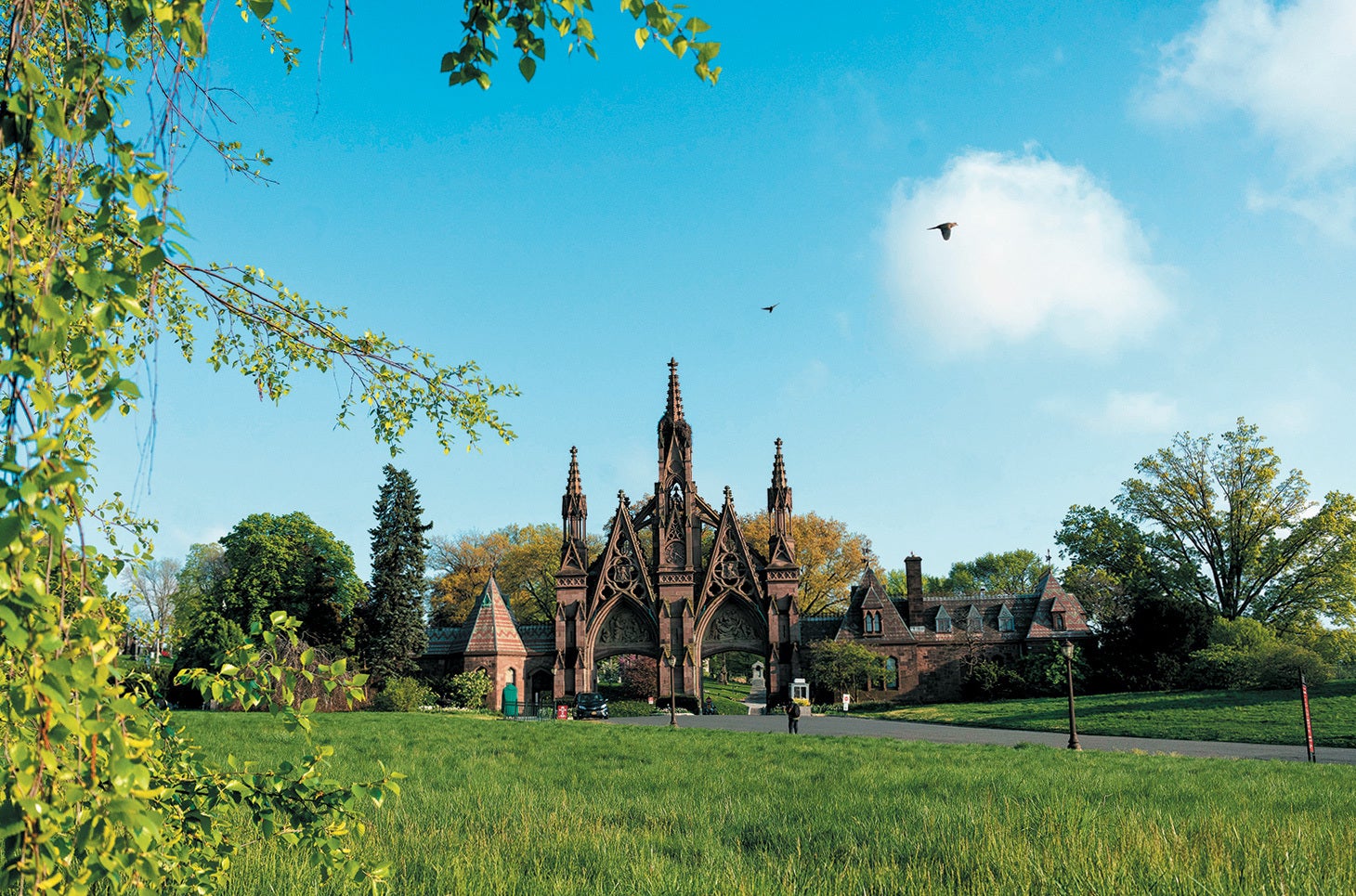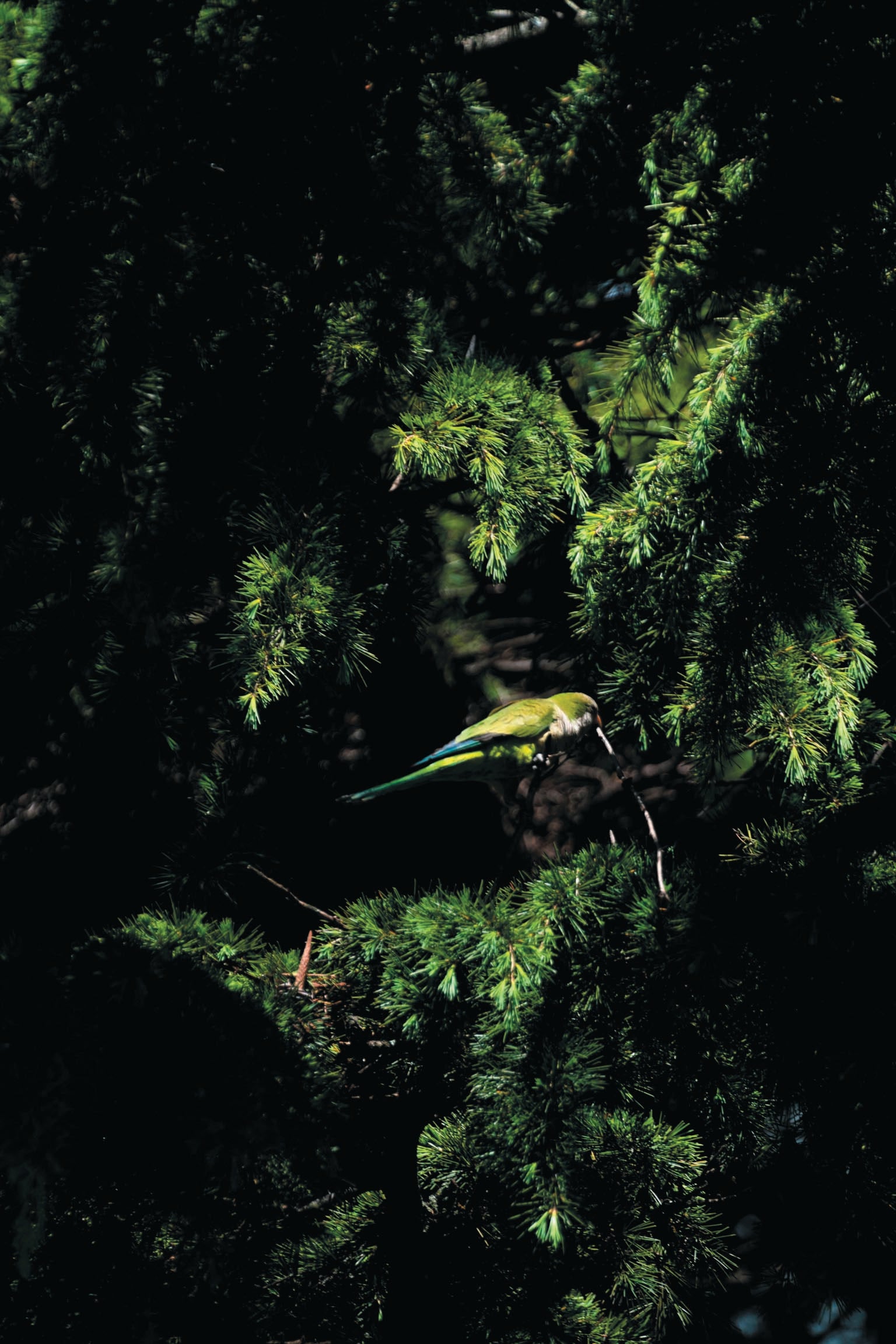It’s not always clear what makes a specific parrot species successful in habitats beyond their native ranges, Smith-Vidaurre explains. But you can get an idea of it with the Monk Parakeets. As early as 1839, Charles Darwin described this species as a major agricultural pest in South America. “These parrots always live in flocks, and commit great ravages on the corn-fields,” he wrote in his journal. “I was told that near Colonia [del Sacramento, Uruguay,] 2500 were killed in the course of one year.”
Monk Parakeets are one of the only parrot species whose members build colonies of stick nests—elaborate, multichambered structures that they maintain cooperatively. These nests allow them to survive in temperate regions of South America, where temperatures regularly drop below 50 or even 40 degrees Fahrenheit on cold winter days—and in New York City with its even colder temperatures.
The Uruguayan government still considers the bird a serious crop pest, and the country’s authorities carry out regular culling. Uruguay also has been a top exporter of the bird for the pet trade over the past 50 years.
The trading of wildlife, including parrots, is highly regulated by local, national and international laws, most notably the Convention on International Trade in Endangered Species of Wild Fauna and Flora (CITES). CITES maintains lists of species whose trade either is forbidden or requires permits, including many parrot species. Monk Parakeets aren’t currently listed, but some places, such as the state of California, ban them as pets because of their invasive potential.
Our attraction to parrots has played a key role in their rise to world domination. Humans have traded and moved these birds around for millennia. Alexander the Great kept parrots he brought back from India in the fourth century B.C.E. The Romans, too, kept exotic parrots as pets. In North America, archaeologists have carbon-dated Scarlet Macaw bones found in New Mexico’s Chaco Canyon—hundreds of miles northwest of the parrots’ Central American range—to the 10th century C.E.
Parrots seem to have started establishing populations outside their native ranges more recently. Research published in the Journal of Zoology documents parrots breeding in the U.K. as early as 1855. But it wasn’t until the 1960s that demand for pet parrots spiked. As more birds were released by or escaped from their owners, colonies started forming in cities around the world. During that era, importers brought Monk Parakeets from South America into the U.S. by the thousands. The birds were breeding in Illinois by 1968 and on Long Island by 1971. They were even reported to be breeding in North Dakota in the 1970s.
Newspapers and local governments in the U.S. were aware of the agricultural damage the birds were doing in their native ranges and also feared they would introduce diseases, says Ben Naddaff-Hafrey, host of the history podcast The Last Archive, which is examining New York City’s Monk Parakeets in an episode. Some pushed for the eradication of the parrots, and by 1974 New York State declared the mission accomplished. But more likely, Naddaff-Hafrey says, interest in eradication efforts waned as concerns about economic impacts faded and locals grew fond of the birds.

Parrots are not new to North America.* The Carolina Parakeet, a gregarious green parrot with a yellow head, inhabited much of the eastern U.S. Its range is thought to have extended from Florida and the Atlantic Coast west to Texas and north to Illinois and even New York State—it probably lived in many of the same places the Monk Parakeet is found in today. Like the Monk Parakeets, Carolina Parakeets regularly shared spaces with humans and were occasionally seen as crop pests. But unlike today’s urban Monk Parakeets, Carolina Parakeets inhabited wet, old-growth forest. They were declared extinct in 1939, probably done in by a combination of deforestation, competition with invasive species, introduced diseases and hunting. Perhaps the Monk Parakeet is taking up some of the niche vacated by the Carolina Parakeet—but it’s also a different bird living in a transformed world, one brimming with opportunities for adaptable species.
Although people may have introduced Monk Parakeets to new locations, the birds themselves have made the most of these novel circumstances. Juan Carlos Senar, who is head of research at the Natural Science Museum of Barcelona, started studying the city’s Monk Parakeets out of curiosity. The museum hosted Monk Parakeet research in the 1970s as well, before the birds became worrisome. After all, it’s objectively interesting to see displaced parrots adapting to different environments. Senar observed changes in the birds’ behavior, such as how at first they bred during the Northern Hemisphere winter, when it was summer in the Southern Hemisphere, then they changed their breeding timing as they got used to their new environments.
Soon the little green parrots were adding new color to the city’s tile work. In 2000 the Catalan government asked whether Senar and his team could undertake a formal census. The researchers found that the birds’ population had exploded. They now number in the thousands.
The species’ impacts have become clear as its numbers have swelled. In the U.S., Monk Parakeets stick to human habitats, where they aren’t directly competing with native wildlife for cavities to nest in like other parrots have to do. But this choice means they sometimes end up in conflict with humans. Often they’ll build their nests on utility poles—risking power outages and fires.
In Barcelona, the birds cause more types of damage. One of Senar’s studies found that in an agricultural area outside the city, parrots caused a loss of 28 percent of the corn crop, 36 percent of the plum crop and 37 percent of the pear crop, among other fruits and vegetables grown there. They also clip many branches from live trees for their nests and eat food that other, native species rely on.
Senar emphasizes that he loves the species—he enjoys watching them and makes a living studying them. But there’s a difference between enjoying a few parakeets and dealing with thousands of them roaming the city. He fears they’ll soon harm ecosystems beyond the city limits if their population isn’t managed: “They’re very clever. If we wait too long, it will be nearly impossible to control them.”
Another, equally adorable parrot species, the Rose-ringed Parakeet (also known as the Ring-necked Parakeet), illustrates how difficult it can be to control these charismatic birds when they set up shop outside their normal range. Like the Monk Parakeet, this species is successful in its native home ranges in South Asia and sub-Saharan Africa, where it can thrive in human-altered habitats. A popular caged bird since at least Victorian times, the green, pink-beaked, long-tailed parrot started escaping increasingly often in the past few decades; before long the Rose-ringed Parakeet established itself in cities across Eurasia and beyond. But unlike Monk Parakeets, Rose-ringed Parakeets don’t build their own nests. They rely on nest cavities, a limited resource for native wildlife—and they aren’t afraid to fight for those spaces.
As the species began colonizing cities, scientists organized to understand the birds and their impact. In 2013 the European Cooperation in Science and Technology funded ParrotNet, a five-year project, headquartered at the University of Kent in England, involving a network of scientists across Europe tasked with monitoring parrots and communicating their findings to local governments.
Emiliano Mori, a researcher at the Italian National Research Council and former ParrotNet member, first noticed the birds on a Mediterranean summer holiday and wondered how they were affecting the native biodiversity. He began observing the parrots and the outcomes of their invasion. Soon he found that Rose-rings were taking nest sites from a small owl called the Eurasian Scops Owl in Italy. The species wasn’t directly reducing the owls’ population, but it was pushing them out of their preferred spots.
Evidence of the negative consequences of Rose-ringed Parakeets’ entry into new locales continues to mount. Research has shown that they outcompete birds at feeding stations in the U.K., and they regularly kill competitors such as Blue Tits and black rats. All the while their populations have been ballooning in cities around the world.
“Their presence is not good,” Mori says. “We can’t tell the complete scope of their impacts, but every time we look, there’s something new to be discovered.” The researchers continue to find new species affected by the birds, he says.
ParrotNet produced policy briefs that were translated into various European languages. Spain has begun removing parakeets. But culling programs are running up against humans’ enduring fascination with these birds.

The parrots’ cute factor continues to be a challenge in efforts to control them, says biologist C. Jane Anderson, who specialized in charismatic invasive species while she was an assistant professor at Texas A&M University Kingsville. Anderson studied Rose-ringed Parakeets on the Hawaiian island of Kauai, where the birds threaten local agriculture and native species. She used culled samples to determine when the birds bred and how to tell the difference between juvenile and adult females—they look similar, but removing (and euthanizing) the latter is more important for population control.
Anderson can recall multiple anecdotes of public protest hindering invasive-parrot management. Humans are drawn to animals with babylike features, called “baby schema ” in psychology: big eyes, big heads and soft bodies. Culling snakes might not lead to much outcry, but people like parrots.
It’s important to remember how the birds arrived in the first place, Anderson says. She doesn’t want to demonize the parrots; rather she views controlling them as undoing the damage humans caused. “The truth is humans moved these animals around,” she says. “I understand why people would be excited to see a parrot in Barcelona. But they shouldn’t be there.”
It’s also important to understand that our cities are not sterile places devoid of wildlife that needs protection. Cities can be as ecologically valuable as the surrounding countryside—New York City is a major migratory bird hotspot, for example. Perhaps the most worrisome consequence of the Rose-ringed Parakeets is that they outcompete and kill a type of threatened bat called the greater noctule at the site of their largest known colony in Europe—an urban park in the Spanish city of Seville.
The paradoxical truth of the matter is that cities can also serve as vital habitat for some parrot species. Australian cities host several native parrots, including the Sulphur-crested Cockatoo. This big, white parrot, named for its sleek yellow mohawk, is a regular sight around gardens in Melbourne, Brisbane, Sydney, and beyond. Although their population is in decline overall, they’re not listed as threatened, and they have found a way to survive successfully in cities. They’ve inhabited urban spaces as long as there have been urban spaces, says Lucy Aplin of the Max Planck Institute of Animal Behavior in Radolfzell, Germany, and the Australian National University. “Parrots have the potential, if given the opportunity, to exhibit rapid adaptation to anthropogenic change.”
In contrast to Monk and Rose-ringed Parakeets, which start breeding between the ages of one and three years and lay at least three eggs at a time, Sulphur-crested Cockatoos don’t generally breed until they’re at least three or four years old, and they lay just two to three eggs per nesting season. They’re particular about where they nest, seeking out large cavities in old trees. Yet they’ve been able to thrive in Australia’s major metropolitan areas.
Certain traits of Sulphur-crested Cockatoos make them quite well suited to city life. For one thing, they are generalists, feeding on whatever food they can find—fruits, invertebrates or a discarded chicken bone. And they’re highly intelligent, social creatures capable of solving problems and teaching their solutions to others. These birds can build a culture around urban living, passing knowledge through social networks like humans do. Aplin studies a behavior that has emerged in Sydney’s Sulphur-crested Cockatoos: they’ve figured out how to open garbage bins. A group of the birds in southern Sydney first learned to open the bins, and they transferred the knowledge to nearby cockatoo roosts. Birds outside the network don’t necessarily know how to do it. Aplin’s work has shown that birds on opposite sides of the network have diverged into subcultures, opening the bins in different ways.
For some imperiled parrot species, cities may be more than just another comfortable place to call home—they can be a lifeline. Parrots whose native populations are threatened with extinction are holding on in some of the world’s largest cities. Consider Hong Kong’s Yellow-crested Cockatoos.
During the 1980s and into the 1990s, pet traders exported tens of thousands of Yellow-crested Cockatoos from their native Indonesia to Hong Kong, says Astrid Alex Andersson, a postdoctoral researcher at the University of Hong Kong. Enough birds escaped captivity or were intentionally released by their owners that they founded a colony in the city. Although much of Hong Kong is forested, these birds prefer to nest and feed in the ornamental trees found in the island’s urban areas and don’t seem to be outcompeting any native species.
About 200 Yellow-crested Cockatoos live in Hong Kong—approximately 10 percent of the bird’s remaining population, says Caroline Dingle of the University of Hong Kong. Population decline from poaching pressure in its native habitat led the International Union for Conservation of Nature to designate the species as critically endangered. Andersson is studying whether the species has found a useful refuge in the city, where it’s not subject to poaching pressure. “It’s possible that these populations, if you do small things to support them in cities, can function as species arks—backup populations for the wild ones,” she says.

Nevertheless, city living isn’t all great for parrots. There’s predation: Mori says feral Rose-ringed Parakeets regularly become prey for raptors, for example. Even for the endangered Yellow-crested Cockatoo, it’ll take further work to determine whether the Hong Kong populations can actually function as a genetic reservoir or whether city life has altered them too much to sustain the species. As part of her research, Andersson is investigating how the city cockatoos differ genetically from the native population.
A similar question preoccupies Smith-Vidaurre. In the U.S., she is looking at the complex vocalizations of Monk Parakeets and how they differ between native and introduced individuals. Each parrot has its own distinctive voice with changes in the frequency of its squawks. She found that the introduced parrots have less complex calls than birds in the native ranges. “Something about their environment might be constraining their ability to produce or perceive these vocal signatures,” she says. How permanent are the changes, she wonders? Would an introduced parrot be able to return to its native range and thrive?
For better, for worse, and sometimes both, parrots have taken over our cities. Their ability to thrive in our altered habitats is a testament to what makes these species special and why we should work to conserve them in the wild while minding the potential impacts of introduced parrots. They’re innovators, problem solvers, socializers and survivors. That’s how they earned our adoration in the first place. Sometimes it’s a joy to stop and marvel at the parrots.
*Editor’s Note (6/23/23): This sentence was edited after posting to correct the description of the history of North America’s parrots.
This article was originally published with the title “Parrot Invasions” in Scientific American 329, 1, 40-49 (July 2023)
doi:10.1038/scientificamerican0723-40

